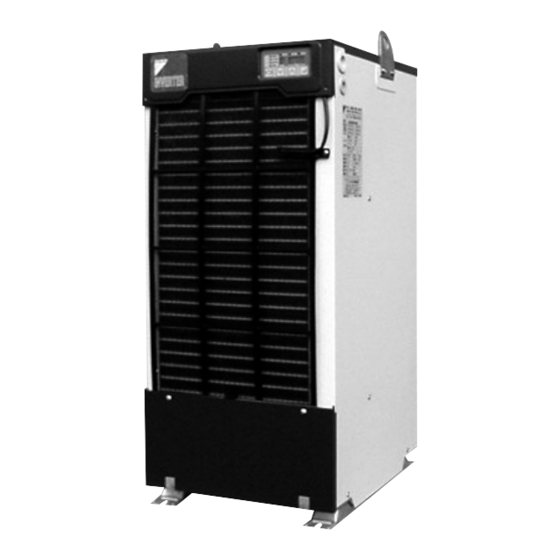
Table of Contents
Advertisement
DAIKIN Oil Cooling Unit
("OILCON")
AKZ8 Series
Models
Menu
Built-in
Standard
breaker
model
model (-B)
Series
AKZ148
AKZ328
AKZ438
AKZ568
AKZ908
Thank you for purchasing DAIKIN Oil Cooling Unit ("OILCON").
This instruction manual includes instructions for using the Oil
Cooling Unit.
To ensure proper use of this product, be sure to read through this
instruction manual before using it.
After reading this manual, keep it handy for your future reference.
Proper use results in power saving
If the air filter is clogged, the cooling performance deteriorates,
causing excess power consumption.
Clean the air filter periodically to reduce power consumption.
Instruction Manual
Circulating type
Built-in heater
Built-in tank
model
model
Built-in breaker
model
CE model
Built-in
Different-
CE model
heater
voltage
(-C)
model (-H)
model (-E)
Installation
Handling
Different-voltage
model
(or Machine Temperature)
Built-in
tank model
(-T1, -T)
Devices (Installed by User)
Maintenance
• When the unit operation seems abnormal
although no alarm is activated
CONTENTS
1
4
5
6
7
12
14
15
16
18
19
20
21
22
23
24
25
27
30
33
33
34
35
36
37
38
Advertisement
Table of Contents

Summarization of Contents
Safety Precautions
Installation Safety
Safety measures for qualified installation, wiring, and grounding.
Usage Safety
Precautions for safe operation, handling, and environmental conditions.
Installation
Oil Cooling Unit and Accessories
Details of included items in the accessory package.
Installation Place and Piping
Requirements for installation location and oil piping guidelines.
Pipe Selection
Guidelines for selecting appropriate pipe sizes for oil connections.
Electrical Wiring and Connections
Procedures for electric wiring, circuit breaker mounting, and control connections.
Electric Wiring Diagram
Detailed schematic of the unit's electrical connections for various models.
Handling
Model Identification and Specifications
Details on identifying models and technical specifications.
Part Names and Functions
Identification and description of major unit components.
Control Panel Overview
Explains the function of each part of the control panel.
Before Operation
Operating Environment
Recommended environmental conditions for unit operation.
Installation and Piping Checks
Verifying secure fastening, air flow, and oil piping integrity.
Applicable Oils
Specifies approved lubrication oils and lists incompatible liquids.
Electric Wiring Checks
Verifying cable size, ground connection, and power supply for safe operation.
Part Names and Functions
Identification and description of major unit components.
Control Panel Overview
Explains the function of each part of the control panel.
Operating Procedure
Operation Mode Selection
Overview of available operation modes and their functions.
Initial Operating Conditions Check
Steps to check and cancel operation lock before starting.
Setting Operation Modes
Details on setting modes like Holding Constant Oil Temp and Tuning Oil Temp.
Holding Constant Oil Temperature
How to set the unit to maintain constant inlet or outlet oil temperature.
Tuning Oil Temperature
Adjusting oil temp based on room or machine temperature.
Cooling Oil at Constant Capacity
Setting the unit to operate at a specified cooling capacity percentage.
Useful Functions
Monitor Items
List of parameters and values viewable in Monitor mode.
Timer Operation
How to set the ON timer for delayed start.
Additional Setting Functions Overview
Overview of extra functions and parameter list.
Parameter Setting Procedure
Step-by-step guide to setting parameters on the control panel.
Temperature Range Warning Function
Setting up warnings for exceeding specified oil temperature ranges.
Auto-tuning Mode for Temp Control
Using auto-tuning to improve temperature control performance.
Alarm/Warning Output Logic
Setting output logic for alarms and warnings to the main machine.
Alarm Settings for Optional Devices
Configuring alarms for external protection devices connected to OP terminals.
Optional Parts
Machine Temperature Tuning Control
Details on optional thermistors for machine temperature monitoring.
Returned Oil Temperature Control
How to use optional thermistors for returned oil temperature control.
Communication with Main Machine
Information on optional boards for unit communication with the main machine.
Maintenance
Daily Maintenance/Inspection
Routine checks for oil, power supply, and abnormal sounds/shaking.
Periodic Maintenance/Inspection
Scheduled tasks like cleaning strainers, air filters, and condensers.
Long-term Storage
Procedures for preparing the unit for extended periods of non-use.
Troubleshooting
Abnormal Operation Checks
Steps to diagnose and resolve issues when the unit operation is abnormal.
Alarm List and Error Codes
Explains common alarm codes, their causes, and corrective actions.















Need help?
Do you have a question about the AKZ328 and is the answer not in the manual?
Questions and answers